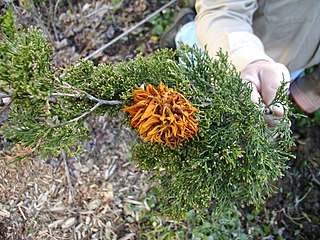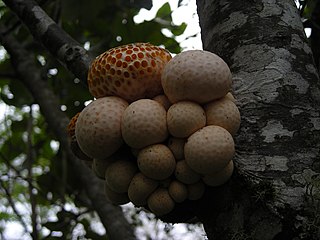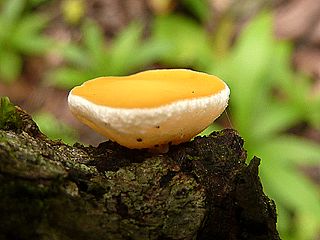
Gymnosporangium is a genus of heteroecious plant-pathogenic fungi which alternately infect members of the family Cupressaceae, primarily species in the genus Juniperus (junipers), and members of the family Rosaceae in the subfamily Amygdaloideae. According to the Dictionary of the Fungi, there are about 57 species in the genus.

Boletus is a genus of mushroom-producing fungi, comprising over 100 species. The genus Boletus was originally broadly defined and described by Carl Linnaeus in 1753, essentially containing all fungi with hymenial pores instead of gills. Since then, other genera have been defined gradually, such as Tylopilus by Petter Adolf Karsten in 1881, and old names such as Leccinum have been resurrected or redefined. Some mushrooms listed in older books as members of the genus have now been placed in separate genera. These include such as Boletus scaber, now Leccinum scabrum, Tylopilus felleus, Chalciporus piperatus and Suillus luteus. More recently, Boletus has been found to be massively polyphyletic, with only a small percentage of the over 300 species that have been assigned to Boletus actually belonging there and necessitating the description and resurrection of many more genera.

Amanita cokeri, commonly known as Coker's Amanita and Solitary Lepidella, is a mushroom in the Amanitaceae family. The mushroom is poisonous. First described as Lepidella cokeri in 1928, it was transferred to the genus Amanita in 1940.

Cyttaria is a genus of ascomycete fungi. About 10 species belong to Cyttaria, found in South America and Australia associated with or growing on southern beech trees from the genus Nothofagus. The "llao llao" fungus Cyttaria hariotii, one of the most common fungi in Andean-Patagonian forests, has been shown to harbor the yeast Saccharomyces eubayanus, which may be source of the lager yeast S. pastorianus cold-tolerance. Cyttaria was originally described by mycologist Miles Joseph Berkeley in 1842.

Russula claroflava, commonly known as the yellow swamp russula or yellow swamp brittlegill, is a basidiomycete mushroom of the genus Russula. It is found in wet places under birch and aspen woodlands across Europe and North America. It has a yellow cap, white gills and stipe and bruises grey. It is mild-tasting and regarded as good to eat.

Paurocotylis is a genus of fungi in the Pyronemataceae family. The genus is monotypic, containing the single species Paurocotylis pila, a truffle-like fungus found in Europe and New Zealand. It was described by Miles Joseph Berkeley in Joseph Dalton Hooker's 1855 publication The Botany of the Antarctic Voyage II, Flora Novae-Zealandiae.

Mutinus is a genus of fungi in the family Phallaceae. The genus was first described by Elias Magnus Fries in 1849. According to the Dictionary of the Fungi, the widespread genus contains 12 species.

Climacodon is a widespread genus of tooth fungi in the family Phanerochaetaceae.
Gnomoniella is a genus of fungi in the family Gnomoniaceae. The genus contains 13 species. Gnomoniopsis is a genus of fungi in the family Gnomoniaceae including:

Xylobolus is a genus of fungi in the Stereaceae family. The Dictionary of the Fungi estimated the genus to contain three widely distributed species; another, X. thoenii, was added in 2011. The genus was circumscribed by Petter Karsten in 1881.
Dubitatio is a fungal genus in the family Massariaceae. According to the 2007 Outline of Ascomycota, the placement of the genus in this family is uncertain. This is a monotypic genus, containing the single species Dubitatio dubitationum, found in temperate South America.

Oudemansiella is a genus of fungi in the Physalacriaceae family. According to the Dictionary of the Fungi, the genus contains about 15 species that are widely distributed in tropical and temperate regions. Yang and colleagues revised the genus in a 2009 publication, describing several new species and several varieties. They classified species in the genus into four sections based on the structure of the cap cuticle: Oudemansiella, Mucidula, Dactylosporina, and Radicatae.

Hapalopilus is a genus of poroid fungi in the family Polyporaceae. The genus is widely distributed. The generic name combines the Ancient Greek words ἁπαλός ("tender") and πιλος ("cap"). Hapalopilus was circumscribed by Finnish mycologist Petter Adolf Karsten in 1881.

Caripia is a fungal genus in the family Marasmiaceae. The genus is monotypic, containing the single species Caripia montagnei, commonly known as the pod parachute. It is found in tropical and subtropical regions of the Americas. Formerly classified in the Stereales, molecular analysis published in 2002 demonstrated that the fungus is a reduced form of the closely related Gymnopus.
Mesophellia is a genus of truffle-like fungi in the Mesophelliaceae family. The genus contains about 15 species that are found in Australia. Mesophellia was circumscribed by Miles Joseph Berkeley in 1857.

Badhamia is a genus of slime molds in the family Physaraceae. It was circumscribed by English naturalist Miles Joseph Berkeley in 1853. The widespread genus contains about 30 species.
William Phillips was a Wales-born English botanist and antiquary.

















